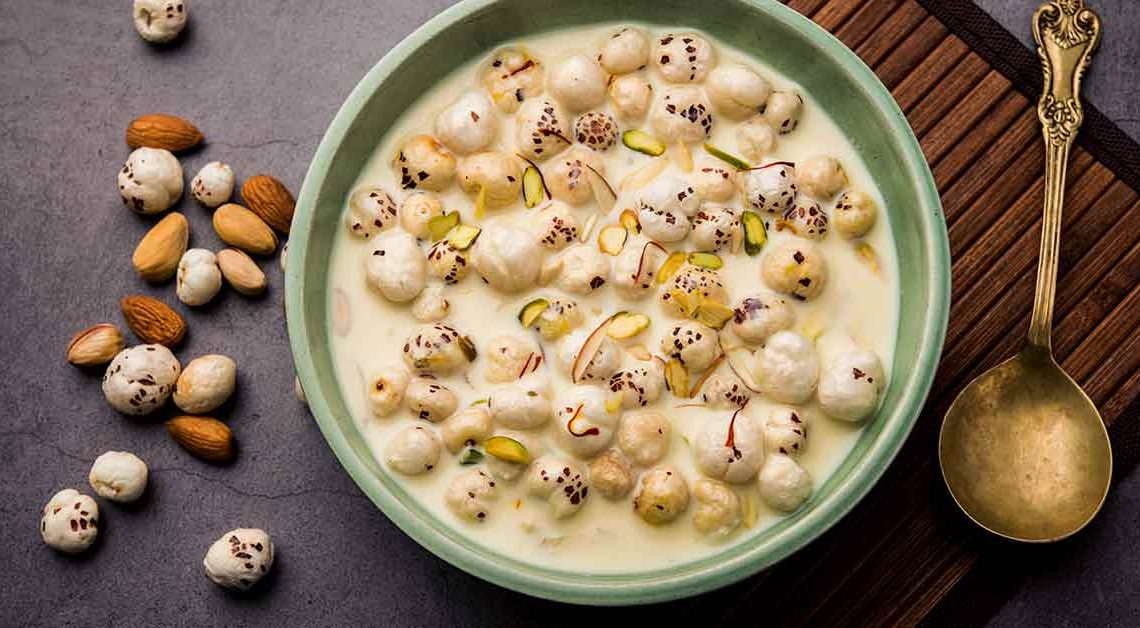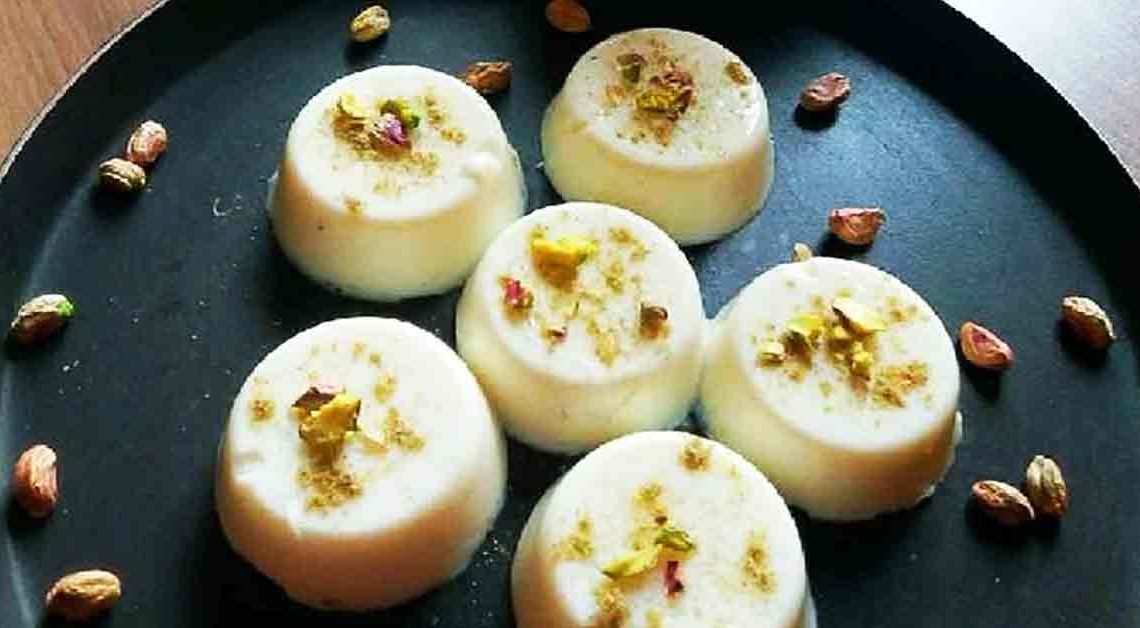Makhana Kheer Delights

When it comes to celebrating Indian desserts, Makhana Kheer stands out as a sweet symphony that whispers elegance and indulgence. This luscious and creamy dessert, also known as Lotus Seed Pudding, is a cherished gem in the rich tapestry of Indian cuisine. Today, I invite you to Mithainama to embark on a culinary journey that will ignite your taste buds and transport you to the heart of India.
Picture this: the Makhana Kheer is like a soothing, creamy embrace that transports you to a world of culinary bliss. Each spoonful is a symphony of textures, from the crunch of roasted Makhana to the silken smoothness of the milk, all laced with the irresistible fragrance of saffron and cardamom.
Join us in this gastronomic exploration as we unlock the secrets of a dessert that embodies the essence of India’s culinary heritage and invites you to savor every spoonful.
Origin of Makhana Kheer
Makhana Kheer, also known as Lotus Seed Pudding, is a delightful Indian dessert with a history deeply rooted in the country’s rich culinary traditions. The origin of Makhana Kheer can be traced back to ancient India, where lotus seeds, or makhana, were not only cherished for their taste but also considered a symbol of purity and spiritual significance.
The use of lotus seeds in Indian cuisine can be dated back thousands of years, mentioned in various ancient texts and scriptures. In Ayurvedic medicine, makhana is valued for its nutritional and medicinal properties, which include being a good source of essential nutrients and having a cooling effect on the body.
Today, it remains a beloved dessert in Indian households, particularly during festivals, celebrations, and special occasions. It embodies the deep cultural and spiritual connections that Indian cuisine often has with the ingredients it uses, making it not just a sweet treat but a symbol of tradition, purity, and culinary innovation.
History of Makhana Kheer
Makhana Kheer, a delectable Indian dessert, has a history that meanders through the annals of time, steeped in both culinary tradition and cultural significance. Its origins can be traced back to ancient India, where the lotus flower, its seeds (makhana), and the act of cooking sweet dishes were integral to daily life.
Lotus seeds, known for their symbolic purity and nutritional value, have been used for centuries in Ayurvedic medicine and cuisine. In Indian mythology, the lotus holds a special place, representing divine beauty and purity.
Over the centuries, it became a fixture in Indian homes, especially during festivals, weddings, and religious ceremonies. It symbolizes not only the creativity and adaptability of Indian cuisine but also carries the deep cultural and spiritual connections that ingredients often hold in the Indian ethos. This creamy, sweet treat weaves together history, tradition, and gastronomic innovation, making it a cherished part of India’s culinary heritage.
Cultural Significance
Makhana Kheer, a sumptuous Indian dessert, carries profound cultural significance in the country’s culinary and social traditions. Here are some key aspects of its cultural importance:
Religious Rituals and Festivals: It often takes center stage during religious ceremonies, festivals, and auspicious occasions. It is offered as prasadam (a religious offering) in temples and is part of traditional celebrations like Navratri, Diwali, and weddings. The creamy sweetness is believed to symbolize blessings and good fortune.
Symbolism: Lotus seeds (makhana) have deep-rooted symbolism in Indian culture. The lotus flower, from which the seeds are harvested, represents purity, enlightenment, and rebirth in Hinduism and Buddhism. By incorporating makhana into kheer, the dessert becomes a representation of these values and is often associated with spirituality and purity.
Nourishment and Healing: In Ayurveda, the traditional system of Indian medicine, makhana is considered a nutritious and healing ingredient. It is often prepared and consumed for its supposed health benefits, such as cooling the body, aiding digestion, and providing essential nutrients just like rajgira or daliya kheer.
Where is Makhana Kheer Famous?
Makhana Kheer, a delightful Indian dessert, is famous and cherished primarily in India. It has a strong presence in various regions across the country and is a popular sweet dish in Indian cuisine. Some of the regions where it is particularly famous include:
North India: It is widely enjoyed in the northern states of India, including Punjab, Uttar Pradesh, Haryana, and Rajasthan. In these regions, it is a common dessert served during festivals, weddings, and special occasions.
Eastern India: In the eastern states of Bihar, Jharkhand, and West Bengal, Makhana Kheer is a traditional dessert, especially during festivals like Chhath Puja. The dish is prepared with local variations and enjoyed as a delicacy.
Western India: In states like Gujarat and Maharashtra, kheer has found its place on dessert menus, often served during celebrations and family gatherings.
Interesting Facts and Trivia
Makhana Kheer is a delectable Indian dessert with a rich history and cultural significance. Here are some interesting facts and trivia related to Makhana Kheer:
- It is a popular dessert during Indian festivals like Diwali, Navratri, and Chhath Puja. Its sweet and creamy nature makes it a must-have during celebratory occasions.
- Makhana is known for its health benefits. It is low in fat, high in protein, and contains essential nutrients. Makhana Kheer is not only delicious but also nutritious.
- One of the unique aspects is the contrast in textures. The soft, creamy milk base is balanced by the crunchy, nutty texture of makhana, creating a delightful mouthfeel.
- It can be adapted for various dietary preferences. It can be prepared with vegan alternatives like almond or coconut milk, and sweeteners like jaggery or stevia for those seeking healthier options.
- It is not just a dessert; it embodies cultural values, spirituality, and family bonding. It is often prepared with love and care for loved ones during special occasions.
Did You Know?
Makhana Kheer not only tantalizes your taste buds but also offers a plethora of health benefits. Here’s why consuming this delightful dessert can be good for you:
- Makhana, the star ingredient in Makhana Kheer, is a nutritional powerhouse. It’s a great source of protein, magnesium, and potassium. These nutrients support muscle function, heart health, and overall well-being.
- Despite its creamy and sweet taste, Makhana Kheer can be a wise choice for those watching their weight. Lotus seeds are low in calories and fat, making this dessert a healthier option when compared to many other sweets.
- Makhana contains dietary fiber, which can aid in digestion and promote a feeling of fullness. This can help prevent overeating and maintain digestive health.
- In Ayurvedic medicine, Makhana is considered a cooling food. It can help soothe the digestive system and reduce heat in the body, making it a popular choice during hot summer months.
- Makhana is rich in antioxidants, which help protect the body from free radicals and oxidative stress. These antioxidants may contribute to anti-aging and overall health.







